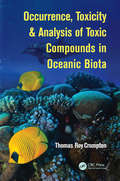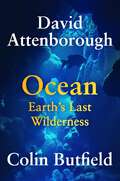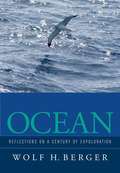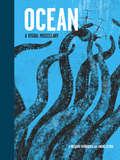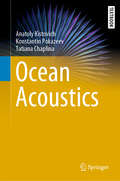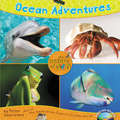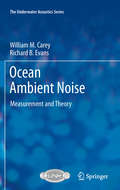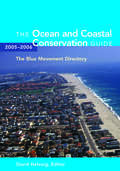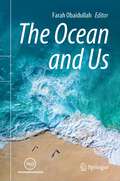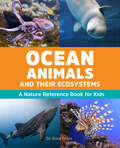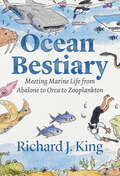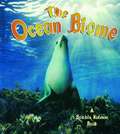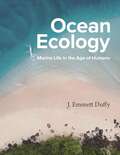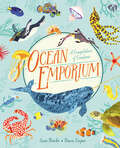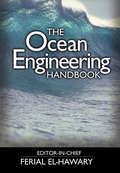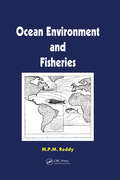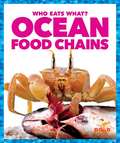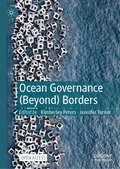- Table View
- List View
Occurrence, Toxicity & Analysis of Toxic Compounds in Oceanic Biota
by Thomas Roy CromptonThe presence of concentrations of organic substances and cations in sea water is a matter of increasing concern to the water industry, environmentalists and the general public alike. There is a threat of possible health hazards to both human, fish and crustacea. Occurrence, Toxicity and Analysis of Marine Biota discusses bioaccumulation in biota as well as occurrence and analysis of toxicants in biota. The main thrust of this book will be a review of the levels of toxicants found in the tissues of fish and invertebrates at various sites throughout the world. In addition, results will be reported on the levels of toxicants found in marine biota enabling ill health or death to occur. This will involve a discussion of toxicity index LC50 and percentile S95 concentration of toxicants and their implications on animal health and mortality, also that of humans who eat these sea creatures. The book will be a complete logical survey of this topic.
Ocean: Earth's Last Wilderness
by Sir David Attenborough Colin ButfieldAward-winning broadcaster and natural historian David Attenborough and longtime collaborator Colin Butfield present a powerful call to action focused on our planet's oceans, exploring how critical this habitat is for the survival of humanity and the earth's future. Through personal stories, history and cutting-edge science, Ocean uncovers the mystery, the wonder, and the frailty of the most unexplored habitat on our planet—the one which shapes the land we live on, regulates our climate, and creates the air we breathe. This book showcase the oceans' remarkable resilience: they can, and in some cases have, recovered the fastest, if we only give them the chance. Drawing a course across David Attenborough's own lifetime, Ocean takes readers on an adventure-laden voyage through eight unique ocean habitats, countless intriguing species, and the most astounding discoveries of the last 100 years, to a future vision of a fully restored marine world—one even more spectacular than we could possibly hope for. Ocean reveals the past, present and potential future of our blue planet. It is a book almost a century in the making, but one that has never been more urgently needed.
Ocean: Reflections on a Century of Exploration
by Wolf H. BergerThe past one hundred years of ocean science have been distinguished by dramatic milestones, remarkable discoveries, and major revelations. This book is a clear and lively survey of many of these amazing findings. Beginning with a brief review of the elements that define what the ocean is and how it works--from plate tectonics to the thermocline and the life within it--Wolf H. Berger places current understanding in the context of history. Essays treat such topics as beach processes and coral reefs, the great ocean currents off the East and West Coasts, the productivity of the sea, and the geologic revolution that changed all knowledge of the earth in the twentieth century.
Ocean: A Visual Miscellany
by Ricardo Henriques Andre LetriaHalf of our planet is covered by the ocean, yet we've only explored 5 percent of this vast underwater realm. Originally published in Portugal, and awarded a highly coveted BolognaRagazzi Mention by the Bologna Book Fair, this visually compelling miscellany offers readers a tsunami of aquatic facts. Which ocean is the largest? Who was the first explorer to sail around the world? Is the ocean truly blue? Beautifully designed and rich with information, Ocean will satisfy enthusiastic readers who enjoy taking a deep dive into a subject as well as more reluctant readers who prefer to dip in and out of a book.
Ocean Acidification
by Committee on the Development of an Integrated Science Strategy for Ocean Acidification Monitoring Research Impacts AssessmentOver recent years, human activities such as the burning of fossil fuels have increased the amount of carbon dioxide gas emitted to the atmosphere--and the amount that dissolves into the ocean. Now, so much carbon dioxide has been absorbed by the ocean that the chemistry of seawater is changing, causing the ocean to become more acidic. Based on a National Research Council report, this booklet describes the well-understood chemistry of ocean acidification and explores the many questions that remain: How will ocean acidification impact marine life such as fish, corals, and shellfish? How will the effects on individual species scale up to whole ecosystems? What will ocean acidification mean for aquaculture, the fishing industry, and coastal tourism?
Ocean Acoustics (Springer Textbooks in Earth Sciences, Geography and Environment)
by Konstantin Pokazeev Anatoly Kistovich Tatiana ChaplinaThis book presents a comprehensive overview of hydroacoustics and describes the physical basis of acoustic processes observed in the sea. In addition, it discusses the basic concepts and provides simplified models of sound propagation and acoustic phenomena at the boundary between environments. Lastly, the book examines in detail a number of applications of ocean acoustics and methods. The ocean is the last reserve of natural resources. It is also an essential element in the biosphere, ensuring the latter’s balance, and plays a pivotal role in the Earth’s climate system and global warming. Consequently, studying the ocean is one of humankind’s most critical scientific tasks, but penetrating its mysteries is no mean feat. Acoustics (hydroacoustics) is one of the most powerful tools for examining the water layer and beyond, since sound waves are the only type of radiation that can propagate over distances of hundreds and even thousands of kilometers in the ocean.This unique resource appeals to specialists working in the fields of ocean and atmosphere physics, students and postgraduate students studying sea physics and oceanology, and anyone who is interested in the problems the ocean is currently facing.
Ocean Adventures
by Peter SchriemerThese two titles have content based upon and supplementing the lessons about God’s creation that are found on the Nature of God DVD collection by Peter Schriemer. These titles, with facts and photos of Hawaii and the Great Lakes habitats and creatures will enrich the lessons taught by Schriemer or can stand alone as informational and fun resources for young readers and their families. The addition of the DVDs showing clips from the Nature of God DVD collections with each book is sure to be a draw for families that are looking for ways to enrich their children’s knowledge of science and nature as well as show, in a beautiful and visual way, that nature is a wonderful gift from God. A quote: Peter Schriemer focuses on a particular ecosystem in the eco-region, how it is designed to sustain life, what amazing creatures and plants live there, and how the science of the creatures and the habitat show evidence of a creator.
Ocean Ambient Noise
by Richard B. Evans William M. CareyThis monograph develops the theory of noise mechanisms and measurements, and describes general noise characteristics and computational methods. The vast ambient noise literature is concisely summarized using theory combined with key representative results. The air sea boundary interaction zone is described in terms of nondimensional variables requisite for future experiments. Noise field coherency, rare directional measurements, and unique basin scale computations and methods are presented. The use of satellite measurements in these basin scale models is demonstrated. A series of appendices provides in-depth mathematical treatments which will be of interest to graduate students and active researchers.
Ocean Anatomy Activities for Kids: Fun, Hands-On Learning (Anatomy Activities for Kids)
by Laura PetrusicExplore like a scientist with this illustrated ocean guide for kids ages 8 to 12 Dive into the big blue sea with Ocean Anatomy Activities for Kids! Travel around the world and down into the deep with illustrations and diagrams that show you how the different parts of the ocean work together. As you read about our amazing aquatic universe, you'll learn how to think like a marine scientist. Ocean Anatomy Activities for Kids goes beyond other marine biology books with: The world underwater—Discover 20 lessons that teach you about everything from kelp forests to coral reefs. Awesome activities—See ocean science in action with fun experiments like creating mini ocean currents and finding out what makes fish float. Your own ocean journal—Answer cool questions after each activity to figure out even more about what makes the ocean so special. Learn all about marine life as you journey the seas with this colorful kids' guide to ocean anatomy.
The Ocean and Coastal Conservation Guide 2005-2006: The Blue Movement Directory
by David HelvargA new environmental movement is emerging to help combat threats to America's oceans and coasts, with hundreds of local and regional groups as well as dozens of national and international organizations being formed. The Ocean and Coastal Conservation Guide represents a comprehensive guide to this new "Blue Movement." This one-of-a-kind new reference details more than 2,000 organizations and institutions that are working to understand, protect, and restore our ocean and coastal areas. For each entry, the book gives contact information including phone and fax numbers, email addresses, web addresses and a brief description of program areas of interest. Along with the state-by-state listings of groups, the directory includes three detailed sections that identify relevant government agencies, academic marine programs, and marine and coastal parks and protected areas. To be published biennially, The Ocean and Coastal Conservation Guide is a vital new resource for anyone interested in the growing community of people working to protect and restore our coastal lands and waters.
The Ocean and Us
by Farah ObaidullahThe Ocean and Us provides an overview of our contemporary understanding of the ocean and all the ways our lives interact with it. It is intended for everyone with an interest in our blue planet. The book brings together the expertise of over 35 ocean specialists from around the world. It explores a wide variety of themes including the importance of a healthy ocean in the fight to halt and contain climate change. It covers issues such as overfishing and pollution, as well as emerging themes such as the blue economy, marine animal welfare and how we can leverage innovation to protect the ocean. The book provides an overview of some of the world’s iconic threatened and at risk ocean ecosystems, and outlines current governance structures and ocean management tools. It also discusses the important social dimensions between people and the ocean, such as ocean and human wellbeing, communities and the ocean, and who gets to participate in the ocean space. The book aims to enhance ocean literacy by making specialist concepts accessible to non-experts, with a view to empowering concerned citizens everywhere to come into action for the ocean, and pave a better way forward for humanity.
Ocean Animals and Their Ecosystems: A Nature Reference Book for Kids
by Dr. Erica ColónMeet marine animals and their ecosystems—a book of ocean exploration for kids 8 to 12 The ocean covers 71 percent of the Earth's surface—and it's swimming with wild and beautiful marine animals. Packed with beautiful photos and interesting facts, this guide goes beyond other nature books for kids, taking you under the sea and into the homes of incredible ocean dwellers. This guide takes you into vibrant coral reefs, jagged coastlines, and icy polar regions. You'll explore how each ecosystem has changed, discover amazing ocean animals through exciting photos, and learn how a rich biodiversity contributes to a healthy ecosystem. This standout among nature books for kids includes: Packed with ocean animals—From powerful sharks to smart octopuses to fascinating deep sea creatures, swim with ocean animals and get to know them through fun facts, such as their diet, lifespan, and weight. Into the deep—Dive deeper than other nature books for kids with in-depth looks at the world's oceans, their ecosystems, and their habitats. Stunning photographs—Vivid, big, colorful photographs not found in other nature books for kids give you an up-close look at these wonderful marine animals and their environment. If you're looking for nature books for kids but aren't sure where to start, this guide will let you swim with and save our marine friends!
Ocean, Atmosphere, and Climate: Cold Years in New Zealand, Investigation Notebook with Article Compilation
by The Lawrence Hall of ScienceNIMAC-sourced textbook
Ocean, Atmosphere, and Climate: Cold Years in New Zealand, Investigation Notebook with Article Compilation
by The Lawrence Hall of ScienceNIMAC-sourced textbook
Ocean Bestiary: Meeting Marine Life from Abalone to Orca to Zooplankton (Oceans In Depth Ser.)
by Richard J. KingA delightful A-to-Z menagerie of the sea—whimsically illustrated, authoritative, and thought-provoking. For millennia, we have taken to the waves. And yet, for humans, the ocean remains our planet’s most inaccessible region, the place about which we know the least. From A to Z, abalone to zooplankton, and through both text and original illustrations, Ocean Bestiary is a celebration of our ongoing quest to know the sea and its creatures. Focusing on individual species or groups of animals, Richard J. King embarks upon a global tour of ocean wildlife, including beluga whales, flying fish, green turtles, mako sharks, noddies, right whales, sea cows (as well as sea lions, sea otters, and sea pickles), skipjack tuna, swordfish, tropicbirds, walrus, and yellow-bellied sea snakes. But more than this, King connects the natural history of ocean animals to the experiences of people out at sea and along the world’s coastlines. From firsthand accounts passed down by the earliest Polynesian navigators to observations from Wampanoag clamshell artists, African-American whalemen, Korean female divers (or haenyeo), and today’s pilots of deep-sea submersibles—and even to imaginary sea expeditions launched through poems, novels, and paintings—Ocean Bestiary weaves together a diverse array of human voices underrepresented in environmental history to tell the larger story of our relationship with the sea. Sometimes funny, sometimes alarming, but always compelling, King’s vignettes reveal both how our perceptions of the sea have changed for the better and how far we still have to go on our voyage.
The Ocean Biome (The Living Ocean Series)
by Kathryn SmithymanThe four zones of the marine bio me,their plants and animals, coral reefs and estuaries, the importance of oceans to the Earth, and how they are in danger.
Ocean Ecology: Marine Life in the Age of Humans
by J. Emmett DuffyA comprehensive introduction to ocean ecology and a new way of thinking about ocean life Marine ecology is more interdisciplinary, broader in scope, and more intimately linked to human activities than ever before. Ocean Ecology provides advanced undergraduates, graduate students, and practitioners with an integrated approach to marine ecology that reflects these new scientific realities, and prepares students for the challenges of studying and managing the ocean as a complex adaptive system. This authoritative and accessible textbook advances a framework based on interactions among four major features of marine ecosystems―geomorphology, the abiotic environment, biodiversity, and biogeochemistry―and shows how life is a driver of environmental conditions and dynamics. Ocean Ecology explains the ecological processes that link organismal to ecosystem scales and that shape the major types of ocean ecosystems, historically and in today's Anthropocene world.
Ocean Emporium: A Compilation of Creatures
by Susie BrooksA treasure trove of extraordinary ocean animals.Beneath the ocean waves lies a web of life that ties together creatures great and small. Fan favorites like hermit crabs and great white sharks share space with mysterious bottom-dwellers like mimic octopuses and giant sea spiders in this gorgeous exploration of the sea. Dive in and encounter some of the earth's most remarkable animals in this gloriously illustrated compendium. A perfect gift for all nature lovers.
The Ocean Engineering Handbook
by Ferial El-HawaryCompiled by an internationally acclaimed panel of experts, this is the most complete reference of its kind. It provides comprehensive coverage of important areas of the theory and practice of oceanic/coastal engineering and technology. The well-organized text includes five major sections: Marine Hydrodynamics and Vehicles Control, Modeling Considerations, Position Control Systems for Offshore Vessels, Applications of Computational Intelligence in the Ocean's Environment, and Fiber Optics in Oceanographic Applications. Designed as a traditional handbook, it offers a detailed look ocean engineering, including thorough coverage of position control theory and implementation.
Ocean Engineering Mechanics
by Michael E. MccormickOcean Engineering Mechanics is designed to give an introduction to water waves and wave-structure interactions for fixed and floating bodies. Linear and nonlinear regular waves are thoroughly discussed, and the methods of determining the averaged properties of random waves are presented. With this foundation in wave mechanics, applications to engineering situations in the coastal zone are then presented. This introduction to the coastal engineering aspects of wave mechanics includes an introduction to shore protection. Covered within are also the basics of wave-structure interactions for situations involving ridged structures, compliant structures, and floating bodies in regular and random seas. The final chapters deal with the various analytical methods available for the engineering analyses of wave-induced forces and motions of floating and compliant structures in regular and random seas. An introduction to the soil-structure interactions is also included. The book can be used for both introductory and advanced courses in ocean engineering mechanics.
Ocean Environment and Fisheries
by M P ReddyThis book contains detailed information on the physical, chemical and biological ceanographic features at various depths for all the 15 regions of the Atlantic, Pacific, Indian and Southern Oceans as categorized by the Food and Agriculture Organization, and on the commercially important marine fishes and details of fish catches in all the 15 regions of the major oceans since 1950. The book provides maximum and minimum annual mean values of various oceanographic factors at different depths and yearly average catches of major fish categories found from an analysis of the distribution of various oceanographic factors and fish catch data for oceans. It also briefly contains some of the recent studies carried out on the influence of oceanographic factors on fisheries. The work studies fisheries forecasts and also reviews factors which influence fisheries in various regions of the major oceans. The book is intended for scientists, teachers and students specializing in fishery oceanography, physical oceanography,
Ocean Food Chains
by Rebecca PettifordIn Ocean Food Chains, early fluent readers explore the ocean biome and the food chains it supports. Vibrant, full-color photos and carefully leveled text engage young readers as they explore how energy flows through plants and animals in a marine environment. A map helps readers identify the world's oceans, and an activity offers kids an opportunity to extend discovery. Children can learn more about ocean food chains using our safe search engine that provides relevant, age-appropriate websites. Ocean Food Chains also features reading tips for teachers and parents, a table of contents, a glossary, and an index. Ocean Food Chains is part of Jump!'s Who Eats What? series.
Ocean Governance: Knowledge Systems, Policy Foundations and Thematic Analyses (MARE Publication Series #25)
by Anna-Katharina Hornidge Maria Hadjimichael Stefan PartelowThis Open Access book on Ocean Governance examines sustainability challenges facing our oceans today. The book is organized into three sections: knowledge systems, policy foundations and thematic analyses. The knowledge produced in the book was catalyzed by the scientific outcomes within the European-funded Cooperation in Science and Technology (COST) network “Ocean Governance for Sustainability – Challenges, Options and the Role of Science”. This network brings together scientists, policy-makers and civil society representatives from 28 nation states to cooperate on ocean governance research. This book offers a compilation of new research material including focused case studies, broad policy syntheses and reflective chapters on the history and current status of knowledge production systems on ocean governance. New research material is presented, although some chapters draw on secondary sources. The book starts with synthetic review chapters from the editors, outlining past and present knowledge systems, addressing how and why ocean governance for sustainability is where it currently stands with critical reflections on existing narratives, path dependencies and colonialist histories. This is followed by chapters addressing, synthesizing and analyzing different legal and policy frameworks for ocean governance both regionally and internationally. At the core of the book are the thematic analyses, which provide focused case studies with detailed contextual information in support of different ocean governance challenges and sustainability pathways around the world. The book concludes with a chapter explicitly targeting students, researchers and policy-makers with key take-away messages compiled by the editors.
Ocean Governance (Beyond) Borders
by Kimberley Peters Jennifer TurnerThis Open Access book “Ocean Governance (Beyond) Borders” is concerned with the persistence of bordering in ocean space, and the possibilities that might arise if we think beyond borders for modes of oceanic management, engaging the ocean’s fluid physicality and the mobile human and more-than-human life entangled with it. At a moment where ocean governance is a pressing topic amongst academics, policy makers, governments and non- governmental agencies alike, this book takes on one of the most overlooked but central devices underscoring many modes of oceanic management: the border. Uniquely combining contemporary border scholarship with cutting edge ocean governance research this book tackles themes ranging from biodiversity conservation and asylum regulations to shipping management measures, tourism, and the growing blue economy. This edited volume hence explores varied bordering practices, whilst also addressing the ‘common-senseness’ with which bordering is deployed at sea, questioning – and problematising – its function and efficacy. Throughout 12 carefully curated chapters, authors ask: What borders are present in the seas and oceans, where and why? In doing this the book offers readers a simple provocation: Do we need borders? And can we govern differently?
